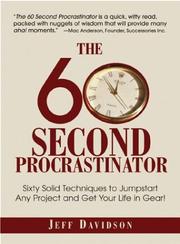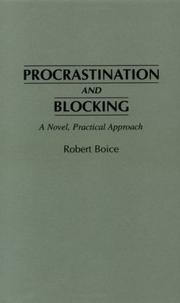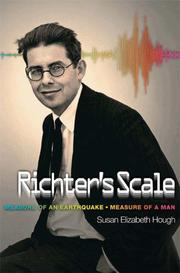| Listing 1 - 8 of 8 |
Sort by
|

ISBN: 1280953586 9786610953585 1605570249 1435607996 9781435607996 9781580629232 1580629237 9781280953583 1580629237 Year: 2004 Publisher: Avon, MA : Adams Media,
Abstract | Keywords | Export | Availability | Bookmark
 Loading...
Loading...Choose an application
- Reference Manager
- EndNote
- RefWorks (Direct export to RefWorks)
Book
ISBN: 1523093935 Year: 2017 Publisher: Oakland, CA : BK,
Abstract | Keywords | Export | Availability | Bookmark
 Loading...
Loading...Choose an application
- Reference Manager
- EndNote
- RefWorks (Direct export to RefWorks)
Procrastination. --- Time management. --- Psychology, Applied. --- Home economics.
Book
ISBN: 012802898X 0128028629 9780128028988 9780128028629 Year: 2016 Publisher: London : Academic Press,
Abstract | Keywords | Export | Availability | Bookmark
 Loading...
Loading...Choose an application
- Reference Manager
- EndNote
- RefWorks (Direct export to RefWorks)
Research on procrastination has grown exponentially in recent years. Studies have revealed that procrastination is an issue of self-regulation failure, and specifically misregulation of emotional states-not simply a time management problem as often presumed. This maladaptive coping strategy is a risk factor not only for poor mental health, but also poor physical health and other aspects of well-being. Procrastination, Health, and Well-Being brings together new and established researchers and theorists who make important connections between procrastination and health. The first section of the book provides an overview of current conceptualizations and philosophical issues in understanding how procrastination relates to health and well-being including a critical discussion of the assumptions and rationalizations that are inherent to procrastination. The next section of the book focuses on current theory and research highlighting the issues and implications of procrastination for physical health and health behaviors, while the third section presents current perspectives on the interrelationships between procrastination and psychological well-being. The volume concludes with an overview of potential areas for future research in the growing field of procrastination, health, and well-being.
Procrastination. --- Well-being. --- Welfare (Personal well-being) --- Wellbeing --- Quality of life --- Happiness --- Health --- Wealth --- Laziness

ISBN: 0275956571 9780313024269 031302426X 9798216001614 Year: 1996 Publisher: Westport, Conn. : London : Praeger, Bloomsbury Publishing,
Abstract | Keywords | Export | Availability | Bookmark
 Loading...
Loading...Choose an application
- Reference Manager
- EndNote
- RefWorks (Direct export to RefWorks)
Procrastination --- Inhibition --- Writer's block --- Angoisse de la feuille blanche --- Procrastination. --- Inhibition. --- Writer's block. --- Free will and determinism --- Habit --- Psychology --- Will --- Impulse --- Laziness --- Block, Writer's --- Authorship --- Psychological aspects
Book
ISBN: 1479858935 Year: 2018 Publisher: New York, NY : New York University Press,
Abstract | Keywords | Export | Availability | Bookmark
 Loading...
Loading...Choose an application
- Reference Manager
- EndNote
- RefWorks (Direct export to RefWorks)
2018 Outstanding Academic Title, given by Choice MagazineHow mobile devices make our in-between moments valuable to media companies while also providing a sense of control and connectionIn moments of downtime – waiting for a friend to arrive or commuting to work – we pull out our phones for a few minutes of distraction. Just as television reoriented the way we think about living rooms, mobile devices have taken over the interstitial spaces of our everyday lives. Ethan Tussey argues that these in-between moments have created a procrastination economy, an opportunity for entertainment companies to create products, apps, platforms, subscription services, micropayments, and interactive opportunities that can colonize our everyday lives.But as businesses commoditize our free time, and mobile devices become essential tools for promotion, branding and distribution, consumers are using these devices as a means of navigating public and private space. These devices are not just changing the way we spend and value our time, but also how we interact with others and transform our sense of the politics of space.By examining the four main locations of the procrastination economy—the workplace, the commute, the waiting room, and the “connected” living room—Ethan Tussey illuminates the relationship between the entertainment industry and the digitally empowered public.
Procrastination. --- Work environment. --- Recreation --- Economic aspects. --- community. --- consumer behavior. --- cultural politics. --- engagement. --- entertainment industry. --- mobile devices. --- new media. --- phone apps. --- screen time. --- smartphones. --- social connections. --- social media. --- user experience. --- wasting time.
Book
ISBN: 9781626259447 1626259445 9781626259454 1626259453 9781626259430 1626259437 Year: 2017 Publisher: Oakland, California : New Harbinger Publications, Inc.,
Abstract | Keywords | Export | Availability | Bookmark
 Loading...
Loading...Choose an application
- Reference Manager
- EndNote
- RefWorks (Direct export to RefWorks)
Behavior modification. --- Depression, Mental. --- Motivation (Psychology) --- Procrastination. --- Laziness --- Action, Psychology of --- Drive (Psychology) --- Psychology of action --- Psychology --- Dejection --- Depression, Unipolar --- Depressive disorder --- Depressive psychoses --- Melancholia --- Mental depression --- Unipolar depression --- Affective disorders --- Neurasthenia --- Neuroses --- Manic-depressive illness --- Melancholy --- Sadness --- Behavioral assessment --- Behaviorism (Psychology) --- Conditioned response --- Human behavior --- Learning, Psychology of --- Psychology, Applied --- Bipolar disorder

ISBN: 1400884446 0691128073 9780691128078 9781400884445 0691173281 9780691173283 Year: 2016 Publisher: Princeton, NJ : Princeton University Press,
Abstract | Keywords | Export | Availability | Bookmark
 Loading...
Loading...Choose an application
- Reference Manager
- EndNote
- RefWorks (Direct export to RefWorks)
By developing the scale that bears his name, Charles Richter not only invented the concept of magnitude as a measure of earthquake size, he turned himself into nothing less than a household word. He remains the only seismologist whose name anyone outside of narrow scientific circles would likely recognize. Yet few understand the Richter scale itself, and even fewer have ever understood the man. Drawing on the wealth of papers Richter left behind, as well as dozens of interviews with his family and colleagues, Susan Hough takes the reader deep into Richter's complex life story, setting it in the context of his family and interpersonal attachments, his academic career, and the history of seismology. Among his colleagues Richter was known as intensely private, passionately interested in earthquakes, and iconoclastic. He was an avid nudist, seismologists tell each other with a grin; he dabbled in poetry. He was a publicity hound, some suggest, and more famous than he deserved to be. But even his closest associates were unaware that he struggled to reconcile an intense and abiding need for artistic expression with his scientific interests, or that his apparently strained relationship with his wife was more unconventional but also stronger than they knew. Moreover, they never realized that his well-known foibles might even have been the consequence of a profound neurological disorder. In this biography, Susan Hough artfully interweaves the stories of Richter's life with the history of earthquake exploration and seismology. In doing so, she illuminates the world of earth science for the lay reader, much as Sylvia Nasar brought the world of mathematics alive in A Beautiful Mind.
Richter scale. --- Seismologists --- Earthquakes. --- Richter, Charles, --- Quakes (Earthquakes) --- Scale, Richter --- Richter, Charles F. --- Richter, C. F. --- Richter, Charles Francis, --- Earth movements --- Natural disasters --- Seismology --- Earthquake magnitude --- Geophysicists --- Measurement --- 1811–12 New Madrid earthquakes. --- 1952 Kern County earthquake. --- Active fault. --- Allen Say. --- American Association of Variable Star Observers. --- Another Woman. --- Asperger syndrome. --- Autism. --- Barbara McClintock. --- Benioff. --- Beno Gutenberg. --- Book. --- Boris Podolsky. --- Calculation. --- Career. --- Charles Francis Richter. --- Child abuse. --- Clarence Allen (geologist). --- Classic book. --- Disaster. --- Distrust. --- Dr. Seuss. --- Dysfunctional family. --- Earthquake insurance. --- Earthquake prediction. --- Electra complex. --- Emerging technologies. --- Emotional baggage. --- Ernest Rutherford. --- Female hysteria. --- Field Act. --- Foreshock. --- Freaks. --- Geologist. --- Graduate school. --- Grandparent. --- Hanks. --- Harold Jeffreys. --- Headline. --- Hiking. --- Hiroo Kanamori. --- His Family. --- Hugo Benioff. --- Hypothyroidism. --- I Wish (manhwa). --- IBM Selectric typewriter. --- In Death. --- Inception. --- Incest. --- Indication (medicine). --- Industrial Workers of the World. --- Inge Lehmann. --- Joan Baez. --- Keiiti Aki. --- Lord Byron. --- Luke Jackson (author). --- Margaret Atwood. --- Mark Storey. --- Meanness. --- Modern physics. --- Mount Wilson Observatory. --- Mrs. --- National security. --- Neurosis. --- Nobel Prize in Physiology or Medicine. --- Nobel Prize. --- Nuclear family. --- Nuclear winter. --- Obsessive–compulsive disorder. --- Plate tectonics. --- Political correctness. --- Popular Science. --- Prediction. --- Procrastination. --- Quantum mechanics. --- Racism. --- Rain Man. --- Ramapo Fault. --- Richter magnitude scale. --- San Andreas Fault. --- Scientist. --- Seismological Society of America. --- Seismology. --- Seismometer. --- Southern California. --- Supervisor. --- Sylvia Nasar. --- Symptom. --- T. S. Eliot. --- Testimonial. --- The Parliament of Man. --- The Tumor. --- Thomas Wolfe. --- To This Day. --- Total loss. --- Treasure trove. --- Tsunami. --- V. --- Virginia Woolf. --- Writing.
Book
Year: 2021 Publisher: Basel, Switzerland MDPI - Multidisciplinary Digital Publishing Institute
Abstract | Keywords | Export | Availability | Bookmark
 Loading...
Loading...Choose an application
- Reference Manager
- EndNote
- RefWorks (Direct export to RefWorks)
Regular physical activity (PA) is both a preventive measure and a cure for non-communicable diseases. Moreover, PA improves mental health, quality of life, and well-being. Conversely, physical inactivity and sedentary lifestyles have negative impacts on individuals, families, and society, as evidenced in particular by the spread of the obesity epidemic. PA has proven to be a low-cost alternative for the treatment and prevention of disease. Therefore, interventions to prevent avoidable diseases by increasing the proportion of physically active people are fundamental. The Special Issue “Physical Activity, Wellness and Health: Challenges, Benefits and Strategies” was collected research articles on anthropometric determinants of health and performance, PA and healthy habits, exercise and diet, exercise and body composition, interventions to promote PA for people of all ages, strategies for the implementation of an active life, and the beneficial effects of exercise on metabolic syndrome. A total of 20 articles were published, falling mainly into the following three areas: anthropometry, health, and sport; health benefits of exercise; population studies and strategies for an active life. All of the studies support strategies to promote PA and reduce sedentary behavior among adolescents, adults and the elderly. There is no doubt that regular exercise is beneficial to health, but the general population should be encouraged to engage in more of it.
handgrip strength --- anthropometry --- handedness --- body composition --- physical activity --- sports practice --- breast cancer --- bioimpedance --- adolescent --- adolescent health --- exercise --- health surveillance --- Kingdom of Saudi Arabia --- National Fitness Programs --- per capita area --- school sports facilities --- urban parks --- rural sports venues --- depression --- mortality --- cardiovascular diseases --- cardiovascular risk factors --- public health --- aging --- dose-response --- cardiorespiratory fitness --- agility test --- executive function --- strength --- older adults --- cardiovascular disease --- healthy ageing --- Ingwavuma --- KwaZulu-Natal --- modifiable behaviour --- rural --- South Africa --- medical diagnostic --- decision tree --- logistic regression --- machine learning --- adolescents --- students --- goal orientation --- emotional intelligence --- burnout --- multiple sclerosis --- accelerometer --- gender differences --- fitness --- foresight --- delphi study --- Europe --- healthy eating intention --- physical activity intention --- emotions --- aversive state --- reinforcement --- social support --- self-concept --- health utility --- quality of life --- rehabilitation --- stroke --- sleep quality --- perceived stress --- mediating effect --- Chinese college students --- dog walking --- health behavior change --- stealth health --- pet ownership --- human–animal interaction --- animal-assisted intervention --- targeted learning --- youth athletes --- soccer --- injury --- overuse --- maturation --- exercise participation --- physical self-concept --- self-esteem --- mental well-being --- mobile phone addiction --- procrastination --- college students --- China --- pandemic --- coronavirus --- physical exercise --- general health --- biopsychosocial model of health --- life course perspective --- university students --- multivariate analysis --- wellbeing --- n/a --- human-animal interaction
| Listing 1 - 8 of 8 |
Sort by
|

 Search
Search Feedback
Feedback About UniCat
About UniCat  Help
Help News
News